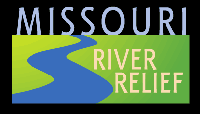The "Common Trees of the Missouri River Bottom: A Guide for Students" was created by Missouri River Relief and was designed to be used by elementary and high school students. The goal of this guide is to provide an engaging, hands-on experience for students beginning to learn about Missouri River floodplain trees. To download directly visit: MOSpace Institutional Repository
Tree Fun Facts
 |
| Comparing and contrasting the different types of leaves |
How do trees access the internet for our new educator resource “Common Trees of the Missouri River Bottoms: A Guide for Students”? They log on! To learn other fun facts about trees of the Missouri River Bottom see facts below or download the guide.
- Their cotton-like seeds are dispersed by the wind, and can be found along the waterline on sandbars and river banks.
- A fast-growing tree, which can grow to over 100 feet high.
- Require flooding or other disturbance to regenerate.
- Eagles build their nest in these trees year after year, because the large branch size can withstand heavy weights.
- The Missouria Indians, whose name means “People with Big Canoes”, used these trees for their dugout canoes.
American Sycamore (Platanus accidentalis)
- The bark flakes off of this waterloving tree.
- One of the largest eastern hardwood trees.
- Small mammals, like raccoons and possums, live in the cavities of the trunk.
- Holds its round “pom-pom” seed clusters throughout most of the winter.
Common Hackberry (Celtis accidentalis)
- Grows really tall on floodplains.
- Pioneers used its tough, flexible wood for cabin floors.
- Attracts winter birds, such as the robin and mockingbird that eat its fruit.
Silver Maple (Acer saccharinum)
Box Elder (Acer negundo)- Named for the silvery underside of their leaves.
- Wood Ducks and other birds like to make nests in the limbs.
- The name Box Elder comes from its former usage in the manufacture of wooden crates, pallets, and boxes.
- These trees, related to maples, help to shelter wildlife and stabilize stream banks.
- Often confused with poison ivy because the leaves can grow in sets of three.
Red Mulberry (Morus rubra)
- Another common tree you may encounter along the Missouri River is the White Mulberry tree, a native of Asia.
- Fishermen often set their lines under fruiting mulberry trees because catfish feed on these berries.
- If you squeeze the leaf stem, you may see some white sap.
- The fruits ripen in spring, and can be eaten raw or used for cooking.
Black Willow (Salix nigra)
- Honey tree--beneficial to bees.
- Provides food to ‘browser’ animals, such as deer, beaver, and rabbit.
- During the American Revolution, the wood of black willow (and of other willows) was made into fine charcoal, which was then used to make gunpowder.
- This is one of many species of willow found in the Missouri River floodplain
- Willows are one of the first trees to colonize new sandbars after a flood.
River Birch (Betula nigra)
- Tend to grow in clumps of multiple trunks, often in groups of three
- Seeds are food for small mammals and birds
Bur Oak (Quercus macrocarpa)
While the trees included in this guide can be found in many Missouri River floodplain forests, the list is not exhaustive for all locations. Many Missouri River floodplain trees can be very tall with leaves out of reach; as such, we formatted this guide to focus on bark providing the most direct identifier for the students. Tree bark is at student level! Because many guides focus on leaves and stems to identify trees, we understand that this is a unique approach to learning tree species.
Big thank you to Kevin Tosie, Student – University of Missouri, Columbia Leif Nordstrom, Student – University of Missouri, Columbia and Ann Koenig, Urban Forester – Missouri Department of Conservation and Felicity Dykas, Head of Digital Service Department- the University of Missouri who made this guide possible.
- Bur Oaks have the largest acorns of any oak tree in North America.
- The slightly toxic acorns were boiled several times before being used as food by many Native American tribes
How to Use this Guide
 |
| 4th graders exploring the Missouri River bottom. |
Thank You for Your Support
 |
| Using all our senses to explore the Missouri River bottom. |
To learn more about our educational resources visit our web page.








